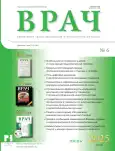Сравнительный анализ диагностической эффективности количественной полимеразой цепной реакции и культурального метода в диагностике урогенитальных инфекций и оценке влагалищной микрофлоры
- Авторы: Каптильный В.А.1, Чилова Р.А.1, Лысцев Д.В.1, Позняк М.В.1
-
Учреждения:
- Первый МГМУ им. И.М. Сеченова Минздрава России (Сеченовский Университет)
- Выпуск: Том 36, № 6 (2025)
- Страницы: 40-43
- Раздел: Из практики
- URL: https://journals.eco-vector.com/0236-3054/article/view/686582
- DOI: https://doi.org/10.29296/25877305-2025-06-08
- ID: 686582
Цитировать
Полный текст
Аннотация
Современная диагностика инфекционно-воспалительных заболеваний и нарушений микрофлоры женского урогенитального тракта требует выбора оптимального лабораторного метода. На основе анализа литературы проводится сравнение диагностической эффективности количественной полимеразной цепной реакции и культурального (микробиологического) метода. Рассматриваются достоинства и недостатки методов. Рациональное использование методов, основанное на их преимуществах и ограничениях, является ключом к эффективной диагностике.
Ключевые слова
Полный текст
Об авторах
В. А. Каптильный
Первый МГМУ им. И.М. Сеченова Минздрава России (Сеченовский Университет)
Автор, ответственный за переписку.
Email: rtchilova@gmail.com
ORCID iD: 0000-0002-2656-132X
SPIN-код: 4312-3455
кандидат медицинских наук, доцент
РоссияР. А. Чилова
Первый МГМУ им. И.М. Сеченова Минздрава России (Сеченовский Университет)
Email: rtchilova@gmail.com
ORCID iD: 0000-0001-6331-3109
SPIN-код: 4137-4848
доктор медицинских наук, профессор
РоссияД. В. Лысцев
Первый МГМУ им. И.М. Сеченова Минздрава России (Сеченовский Университет)
Email: rtchilova@gmail.com
ORCID iD: 0009-0006-3826-3174
Россия
М. В. Позняк
Первый МГМУ им. И.М. Сеченова Минздрава России (Сеченовский Университет)
Email: rtchilova@gmail.com
ORCID iD: 0009-0006-8217-0784
Россия
Список литературы
- Workowski K.A., Bachmann L.H., Chan P.A. et al. Sexually transmitted infections treatment guidelines, 2021. MMWR Recomm Rep. 2021; 70 (4): 1–187. doi: 10.15585/mmwr.rr7004a1
- Unemo M., Bradshaw C.S., Hocking J.S. et al. Sexually transmitted infections: challenges ahead. Lancet Infect Dis. 2017; 17 (8), e235-e279. doi: 10.1016/S1473-3099(17)30310-9
- Национальное руководство по акушерству. Под ред. Г.М. Савельевой, Г.Т. Сухих, В.Н. Серова, В.Е. Радзинского. 2-е изд., перераб. и доп. М.: ГЭОТАР-Медиа, 2022; 1080 с. [National Guidelines for Obstetrics. Ed. by G.M. Savelyeva, G.T. Sukhikh, V.N. Serov, V.E. Radzinsky. 2nd ed., revised and expanded. Moscow: GEOTAR-Media, 2022; 1080 pp. (in Russ.)].
- Национальное руководство по лабораторной диагностике. Под ред. В.В. Долгова, В.В. Меньшикова. М., 2013; 928 с. [National Guidelines for Laboratory Diagnostics. Edited by V.V. Dolgov, V.V. Menshikov. Moscow, 2013; 928 p. (in Russ.)].
- Chernesky M., Jang D., Luinstra K. et al. High analytical sensitivity and low rates of inhibition may contribute to detection of Chlamydia trachomatis in significantly more women by the APTIMA Combo 2 assay. J Clin Microbiol. 2006; 44 (2): 400–5. doi: 10.1128/JCM.44.2.400-405.2006
- Schachter J., Chernesky M.A., Willis D.E. et al. Vaginal swabs are the specimens of choice when screening for Chlamydia trachomatis and Neisseria gonorrhoeae: results from a multicenter evaluation of the APTIMA assays for both infections. Sex Transm Dis. 2005; 32 (12): 725–8. doi: 10.1097/01.olq.0000190092.59482.96
- Unemo M., Shafer W.M. Antimicrobial resistance in Neisseria gonorrhoeae in the 21st century: past, evolution, and future. Clin Microbiol Rev. 2014; 27 (3): 587–613. doi: 10.1128/CMR.00010-14
- Van Der Pol B., Ferrero D.V., Buck-Barrington L. et al. Multicenter evaluation of the BDProbeTec ET System for detection of Chlamydia trachomatis and Neisseria gonorrhoeae in urine specimens, female endocervical swabs, and male urethral swabs. J Clin Microbiol. 2001; 39 (3): 1008–16. doi: 10.1128/JCM.39.3.1008-1016.2001
- Schwebke J.R., Hobbs M.M., Taylor S.N. et al. Molecular testing for Trichomonas vaginalis in women: results from a prospective U.S. clinical trial. J Clin Microbiol. 2011; 49 (12): 4106–11. doi: 10.1128/JCM.01291-11
- Huppert J.S., Mortensen J.E., Reed J.L. et al. Rapid antigen testing compares favorably with transcription-mediated amplification assay for the detection of Trichomonas vaginalis in young women. Clin Infect Dis. 2007; 45 (2): 194–8. doi: 10.1086/518851
- Jensen J.S., Cusini M., Gomberg M. et al. 2016 European guideline on Mycoplasma genitalium infections. J Eur Acad Dermatol Venereol. 2016; 30 (10): 1650–6. doi: 10.1111/jdv.13849
- Lis R., Rowhani-Rahbar A., Manhart L.E. (2015). Mycoplasma genitalium infection and female reproductive tract disease: a meta-analysis. Clin Infect Dis. 2015; 61 (3): 418–26. doi: 10.1093/cid/civ312
- Shipitsyna E., Roos A., Datcu R. et al. (2013). Composition of the vaginal microbiota in women of reproductive age – sensitive and specific molecular diagnosis of bacterial vaginosis is possible? PLoS One. 2013; 8 (4): e60670. doi: 10.1371/journal.pone.0060670
- Fredricks D.N., Fiedler T.L., Marrazzo J.M. (2005). Molecular identification of bacteria associated with bacterial vaginosis. N Engl J Med. 2005; 353 (18): 1899–911. doi: 10.1056/NEJMoa043802
- Rumyantseva T.A., Bellen G., Romanuk T.N. et al. Utility of microscopic techniques and quantitative real-time polymerase chain reaction for the diagnosis of vaginal microflora alterations. J Low Genit Tract Dis. 2015; 19 (2): 124–8. doi: 10.1097/LGT.0000000000000060
- Menard J.P., Mazouni C., Salem-Cherif I. et al. (2010). High vaginal concentrations of Atopobium vaginae and Gardnerella vaginalis in women undergoing preterm labor. Obstet Gynecol. 2010; 115 (1): 134–40. doi: 10.1097/AOG.0b013e3181c391d7
- Mushi M.F., Bader O., Taverne-Ghadwal L. et al. Crucial role of fluconazole-diffusion tests for the identification of Candida glabrata in resource-limited settings. Journal of Fungi. 2010; 2 (4): 29.
- Ahmad A., Khan A.U. Prevalence of Candida species and potential risk factors for vulvovaginal candidiasis in Aligarh, India. Eur J Obstet Gynecol Reprod Biol. 2009; 144 (1): 68–71. doi: 10.1016/j.ejogrb.2008.12.020
Дополнительные файлы






